radiator cap CHEVROLET SUBURBAN 1996 Owners Manual
[x] Cancel search | Manufacturer: CHEVROLET, Model Year: 1996, Model line: SUBURBAN, Model: CHEVROLET SUBURBAN 1996Pages: 486, PDF Size: 26.58 MB
Page 244 of 486
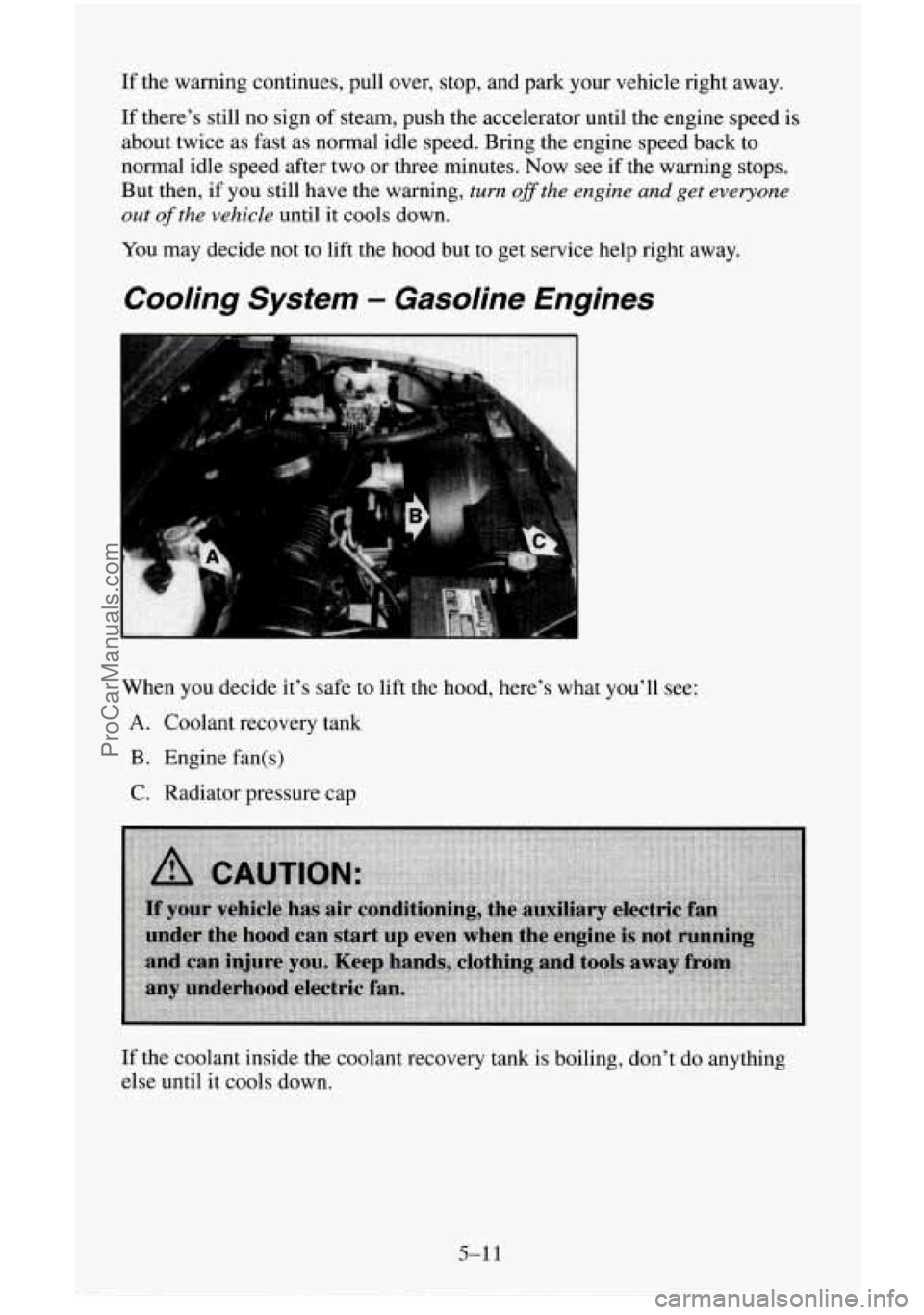
If the warning continues, pull over, stop, and park your vehicle right away.
If there’s still no sign of steam, push the accelerator until the engine speed is
about twice as fast as normal idle speed. Bring the engine speed back
to
normal idle speed after two or three minutes. Now see if the warning stops.
But then, if you still have the warning,
turn ofthe engine and get everyone
out
of the vehicle until it cools down.
You may decide not to lift the hood but to get service help right away.
Cooling System - Gasoline Engines
When you decide it’s safe to lift the hood, here’s what you’ll see:
A. Coolant recovery tank
B . Engine fan( s)
C. Radiator pressure cap
If the coolant inside the coolant recovery tank is boiling, don’t do anything
else until
it cools down.
5-1 1
ProCarManuals.com
Page 248 of 486
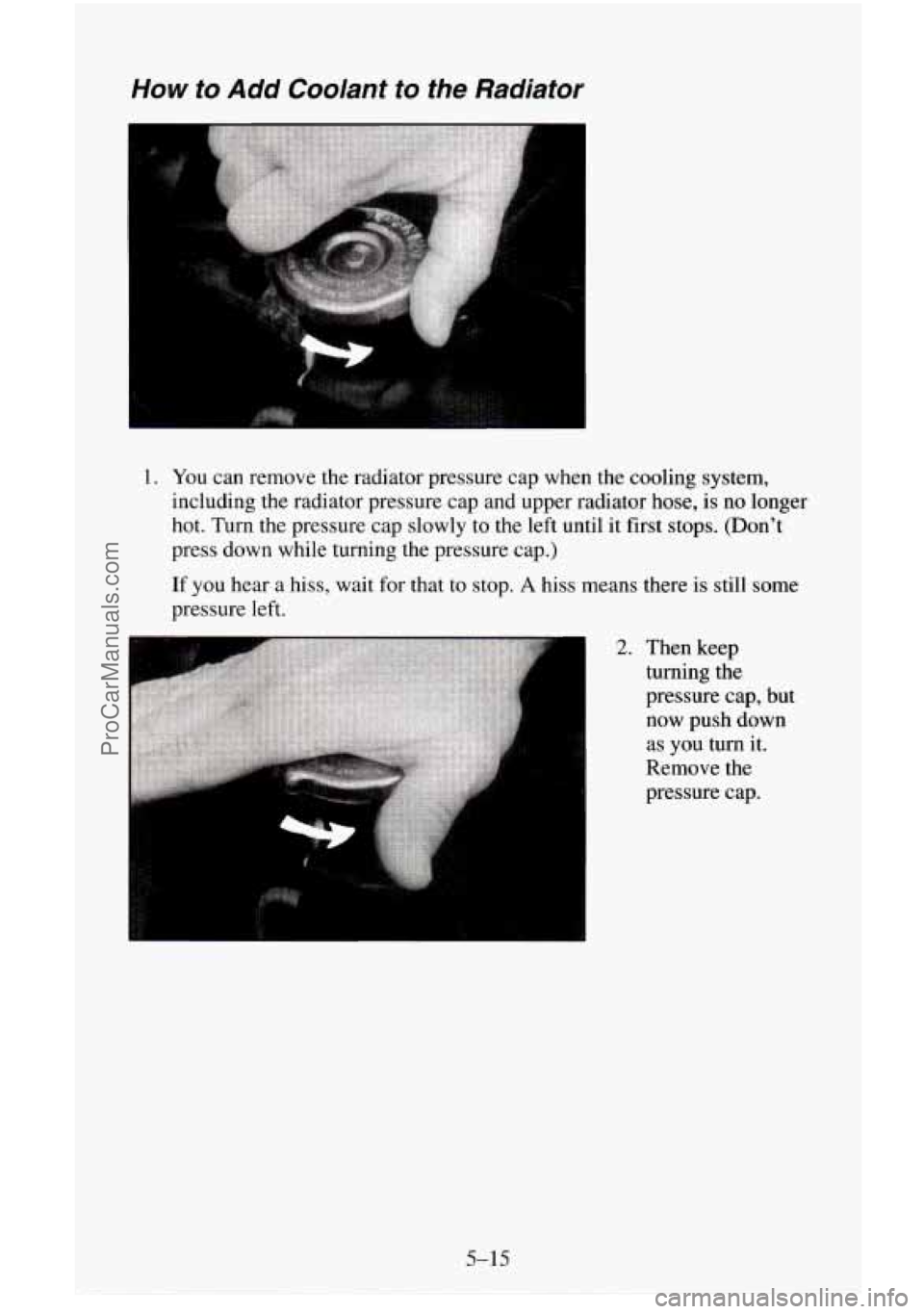
How to Add Coolant to the Radiator
1. You can remove the radiator pressure cap when the cooling system,
including the radiator pressure cap and upper radiator hose,
is no longer
hot. Turn the pressure cap slowly to the left until
it first stops. (Don’t
press down while turning the pressure cap.)
If you hear a hiss, wait for that to stop.
A hiss means there is still some
pressure left.
2. Then keep turning the
pressure cap, but
now push down
as you turn it.
Remove the
pressure cap.
5-15
ProCarManuals.com
Page 249 of 486
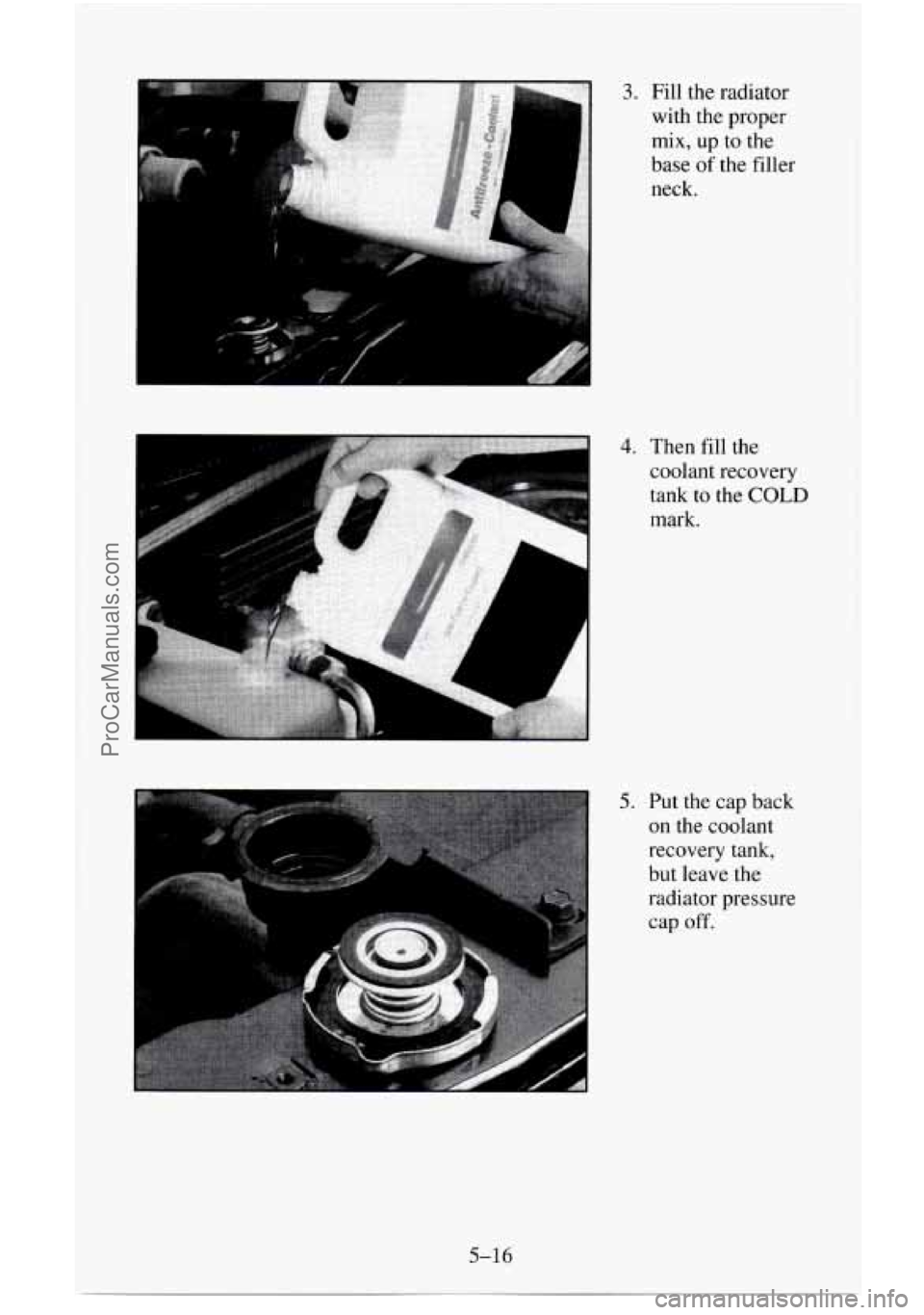
3. Fill the radiator with the proper
mix, up to the
base
of the filler
neck.
4. Then fill the
coolant recovery
tank to the
COLD
mark.
5. Put the cap back
on the coolant
recovery tank,
but leave the
radiator pressure
cap
off.
5-1 6
ProCarManuals.com
Page 250 of 486
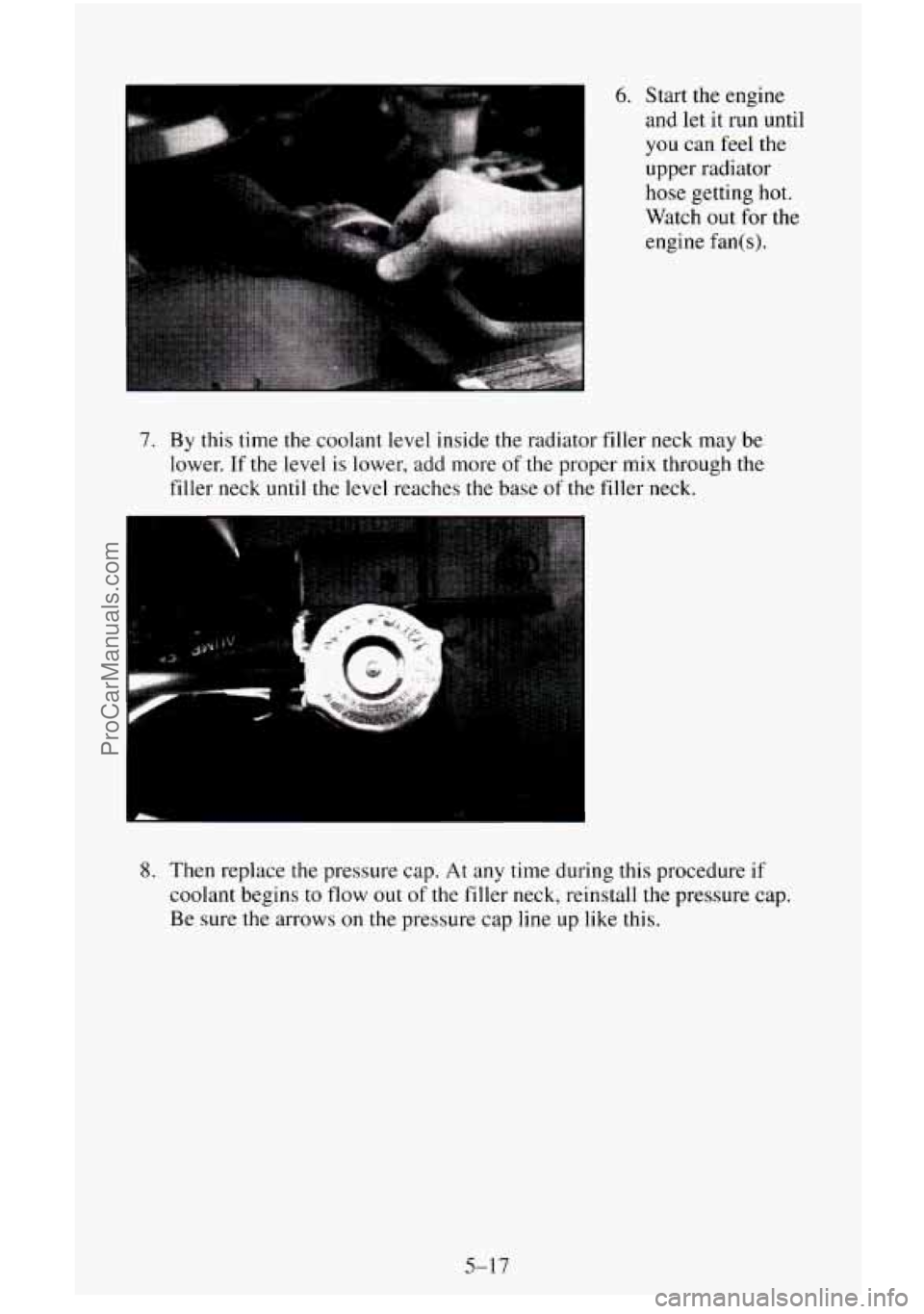
I
6. Start the engine
and let it run until
you can feel the
upper radiator
hose getting hot.
Watch
out for the
engine fan(s).
7. By this time the coolant level inside the radiator filler neck may be
lower. If the level
is lower, add more of the proper mix through the
filler neck until the level reaches the base of the filler neck.
8. Then replace the pressure cap. At any time during this procedure if
coolant begins to flow out of the filler neck, reinstall the pressure cap.
Be sure the arrows
on the pressure cap line up like this.
5-1 7
ProCarManuals.com
Page 251 of 486
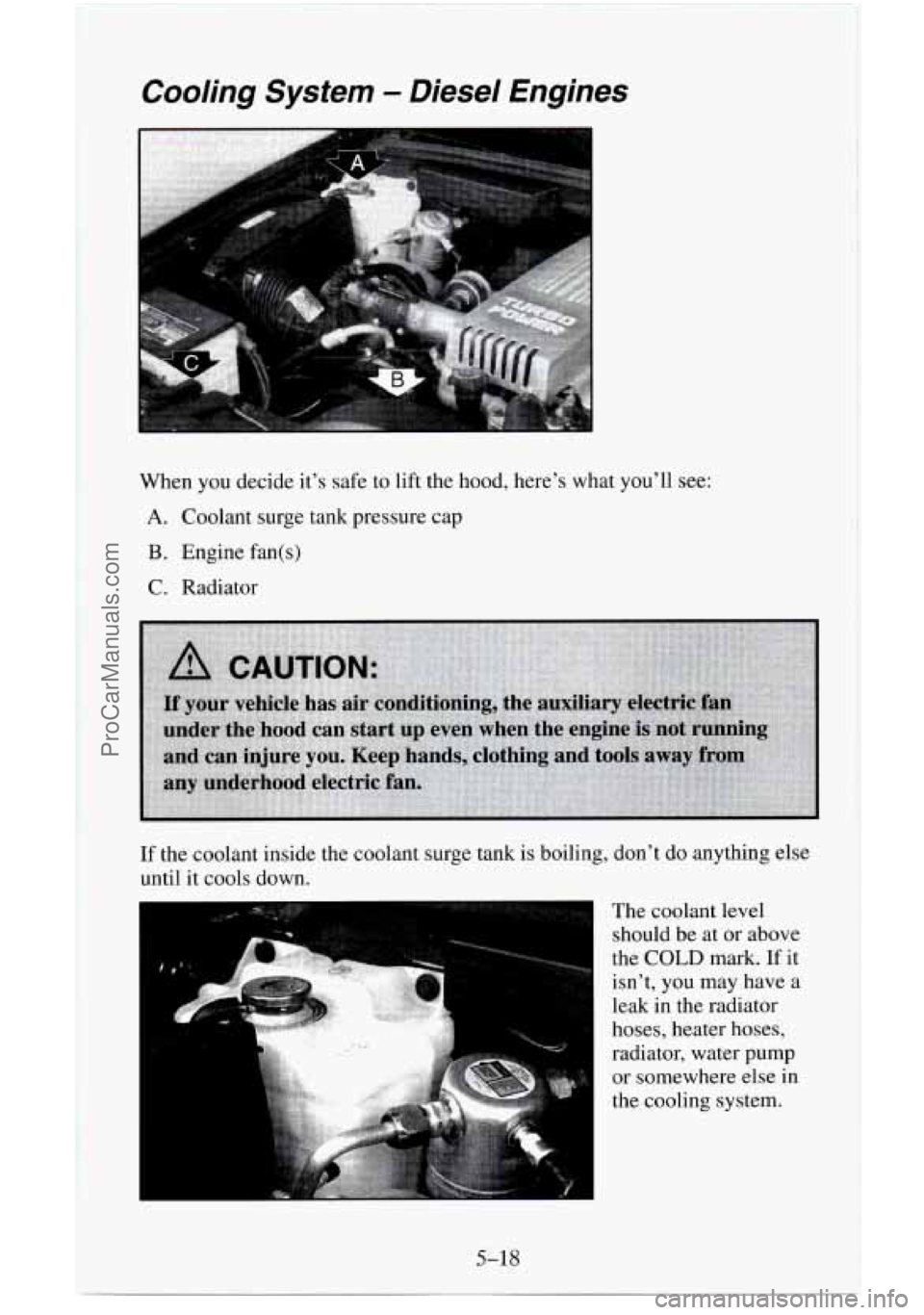
Cooling System - Diesel Engines
When you decide it’s safe to lift the hood, here’s what you’ll see:
A. Coolant surge tank pressure cap
B. Engine fan(s)
C. Radiator
If the coolant inside the coolant surge tank is boiling, don’t do anything else
until
it cools down.
The coolant level
should be at or above
the
COLD mark. If it
isn’t,
you may have a
leak in the radiator
hoses, heater hoses,
radiator, water pump
1 or somewhere else in
the cooling system.
5-18
ProCarManuals.com
Page 254 of 486
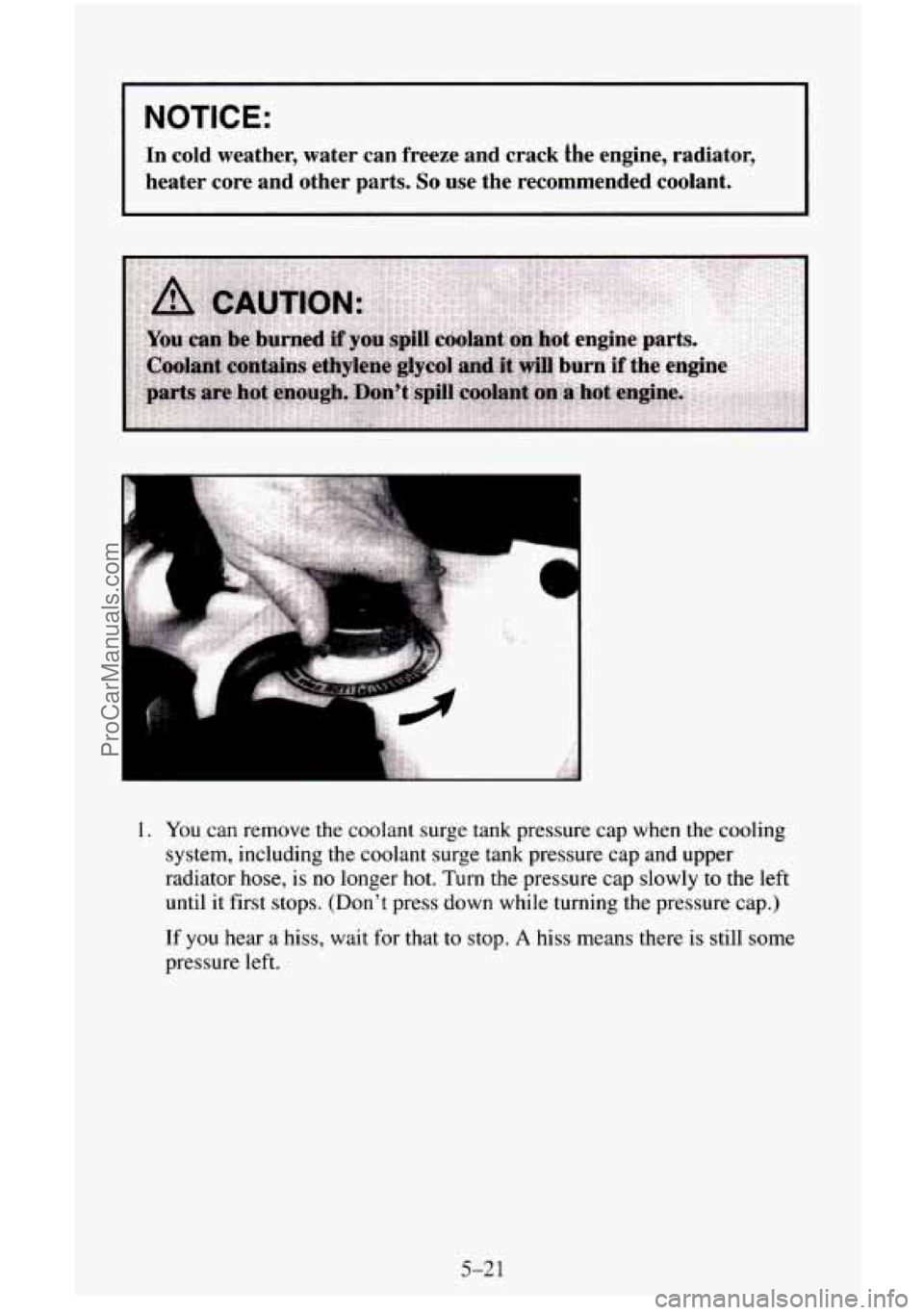
NOTICE:
In cold weather, water can freeze and crack the engine, radiat\
or,
heater core and other parts.
So use the recommended coolant.
1. You can remove the coolant surge tank pressure cap when the cooling
system, including the coolant surge tank pressure cap and upper
radiator hose, is no longer hot. Turn the pressure cap slowly to the left
until
it first stops. (Don’t press down while turning the pressure cap.)
If you hear a hiss, wait for that
to stop. A hiss means there is still some
pressure left.
5-21
ProCarManuals.com
Page 256 of 486
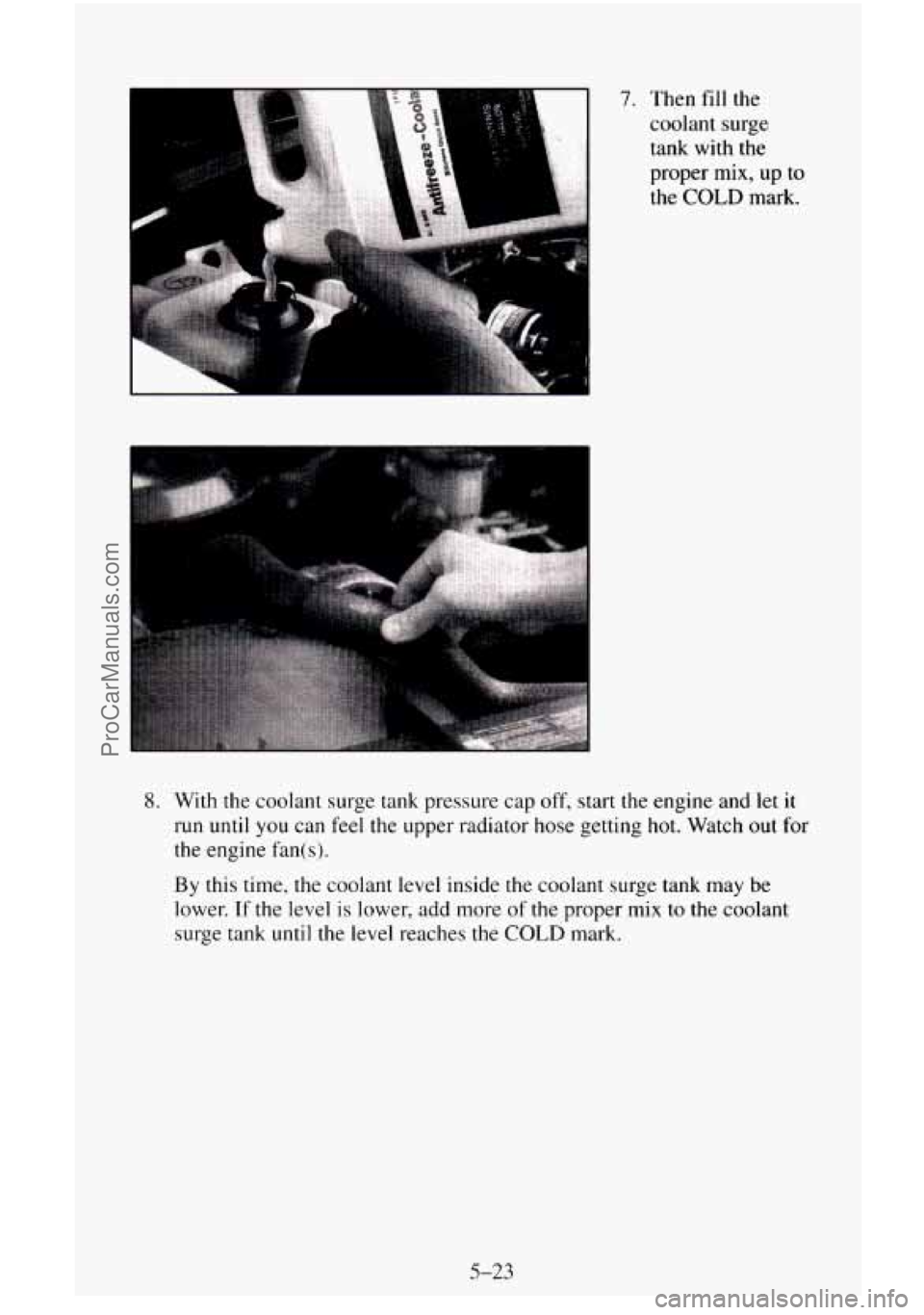
7. Then fill the coolant
surge
tank with the
proper mix, up to
the COLD mark.
8. With the coolant surge tank pressure cap off, start the engine and let it
run until you can feel the upper radiator hose getting hot. Watch out for
the engine fan(s).
By this time, the coolant level inside
the coolant surge tank may be
lower. If the level is lower, add more of the proper mix to the coolant
surge tank until the level reaches the
COLD mark.
5-23
ProCarManuals.com
Page 313 of 486
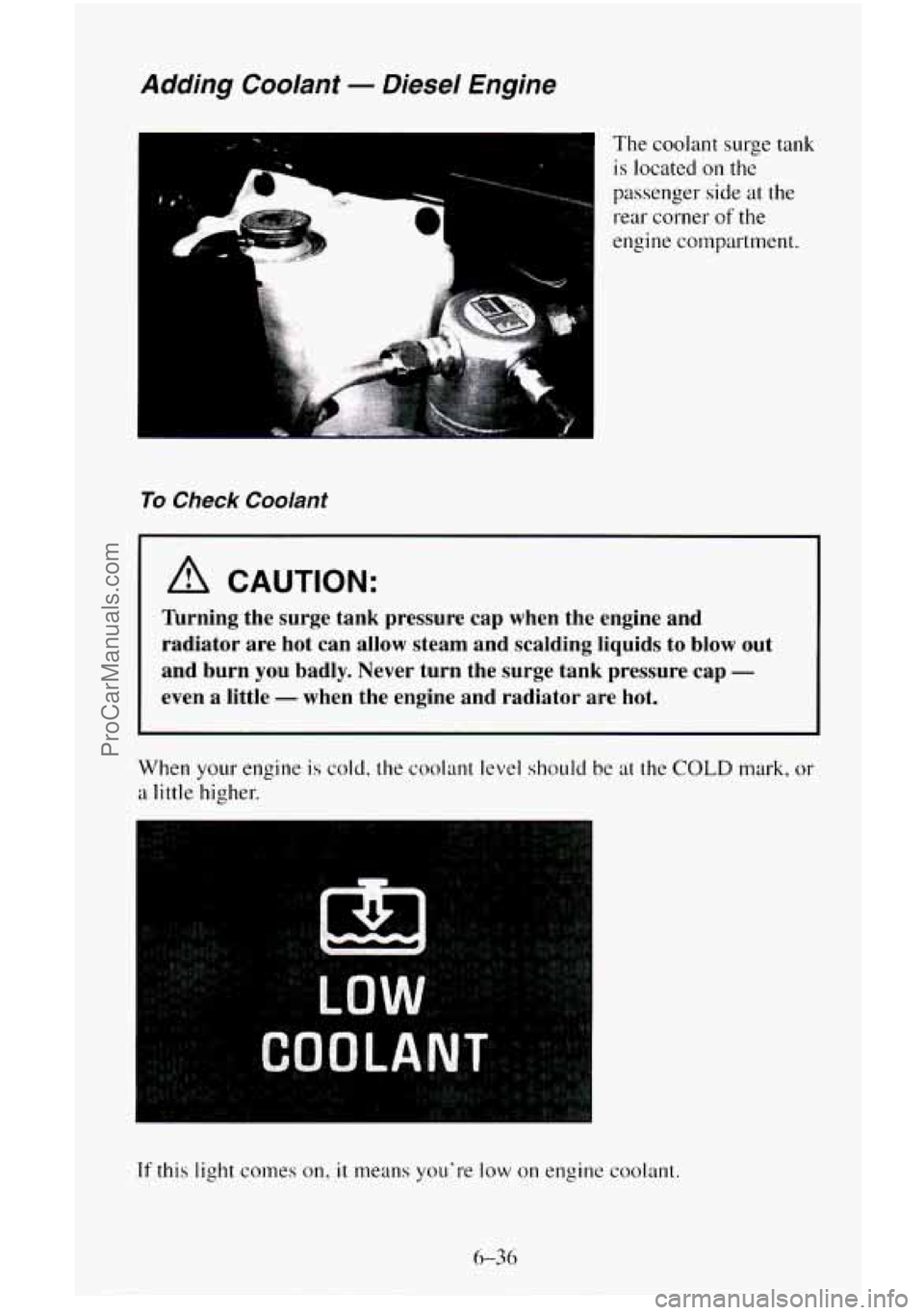
Adding Coolant - Diesel Engine
x " The coolant surge tank is located on
the
passenger side at the
rear corner of the
engine compartment.
To Check Coolant
A CAUTION:
lbrning the surge tank pressure cap when the engine and
radiator are hot can allow steam and scalding liquids to blow \
out
and burn you badly. Never turn the surge tank pressure
cap -
even a little - when the engine and radiator are hot.
When your engine is cold, the coolant level should be at the COLD mark. or
a little higher.
If this light comes on, it means you're low on engine coolant.
6-36
ProCarManuals.com
Page 314 of 486
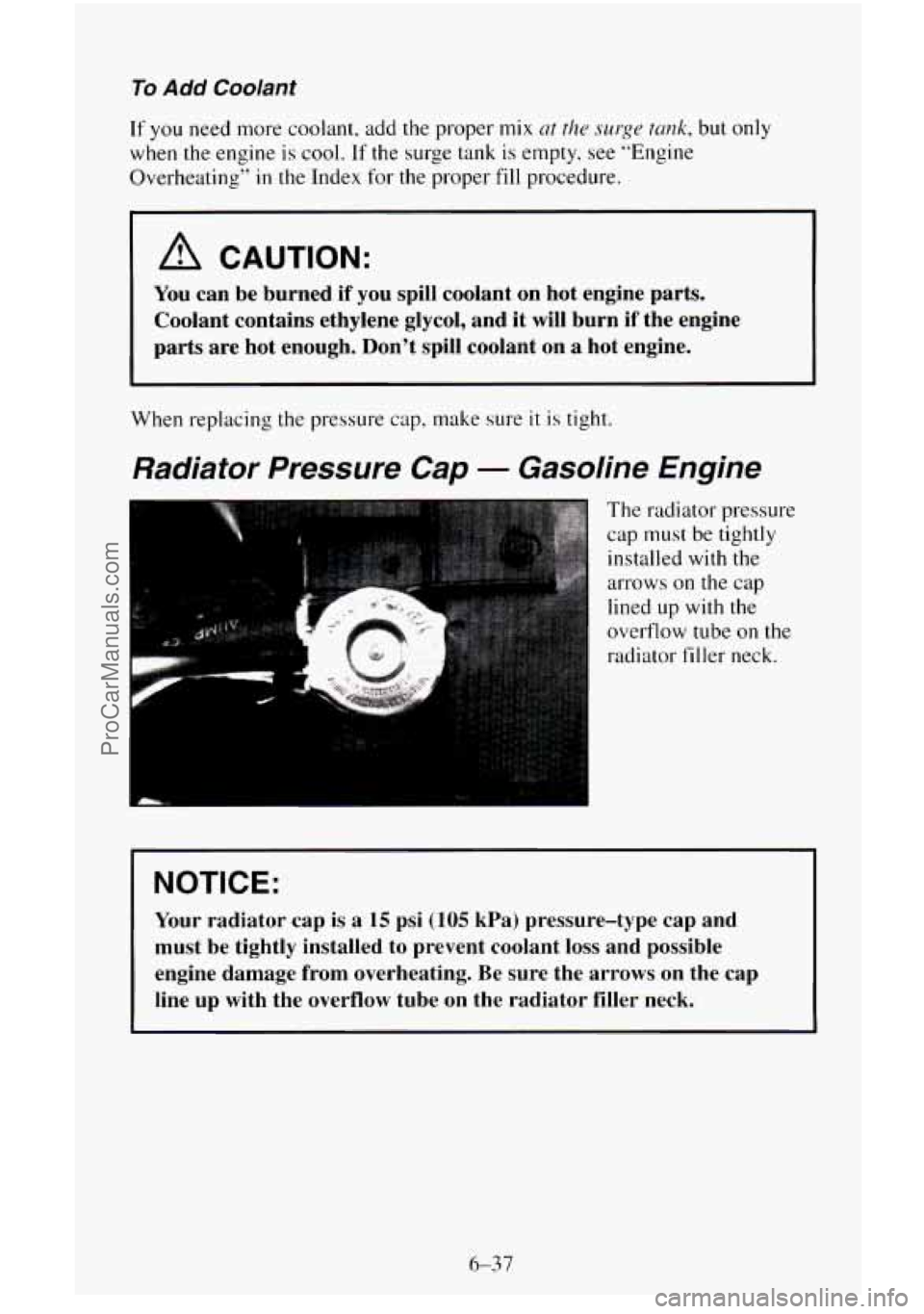
To Add Coolant
If you need more coolant, add the proper mix crt the surge tunk, but only
when the engine
is cool. If the surge tank is empty, see “Engine
Overheating”
in the Index for the proper fill procedure.
A CAUTION:
You can be burned if you spill coolant on hot engine parts.
Coolant contains ethylene glycol, and
it will burn if the engine
parts are hot enough. Don’t spill coolant on
a hot engine.
When replacing the pressure
cap, make sure it is tight.
Radiator Pressure Cap - Gasoline Engine
The radiator pressure
cap
must be tightly
installed
with the
arrows on the cap
lined up with the
overflow tube
on the
radiator filler neck.
U
NOTICE:
Your radiator cap is a 15 psi (105 kPa) pressure-type cap and
must be tightly installed to prevent coolant
loss and possible
engine damage from overheating. Be sure the arrows on the cap
line up with the overflow tube on the radiator filler neck.
ProCarManuals.com
Page 315 of 486
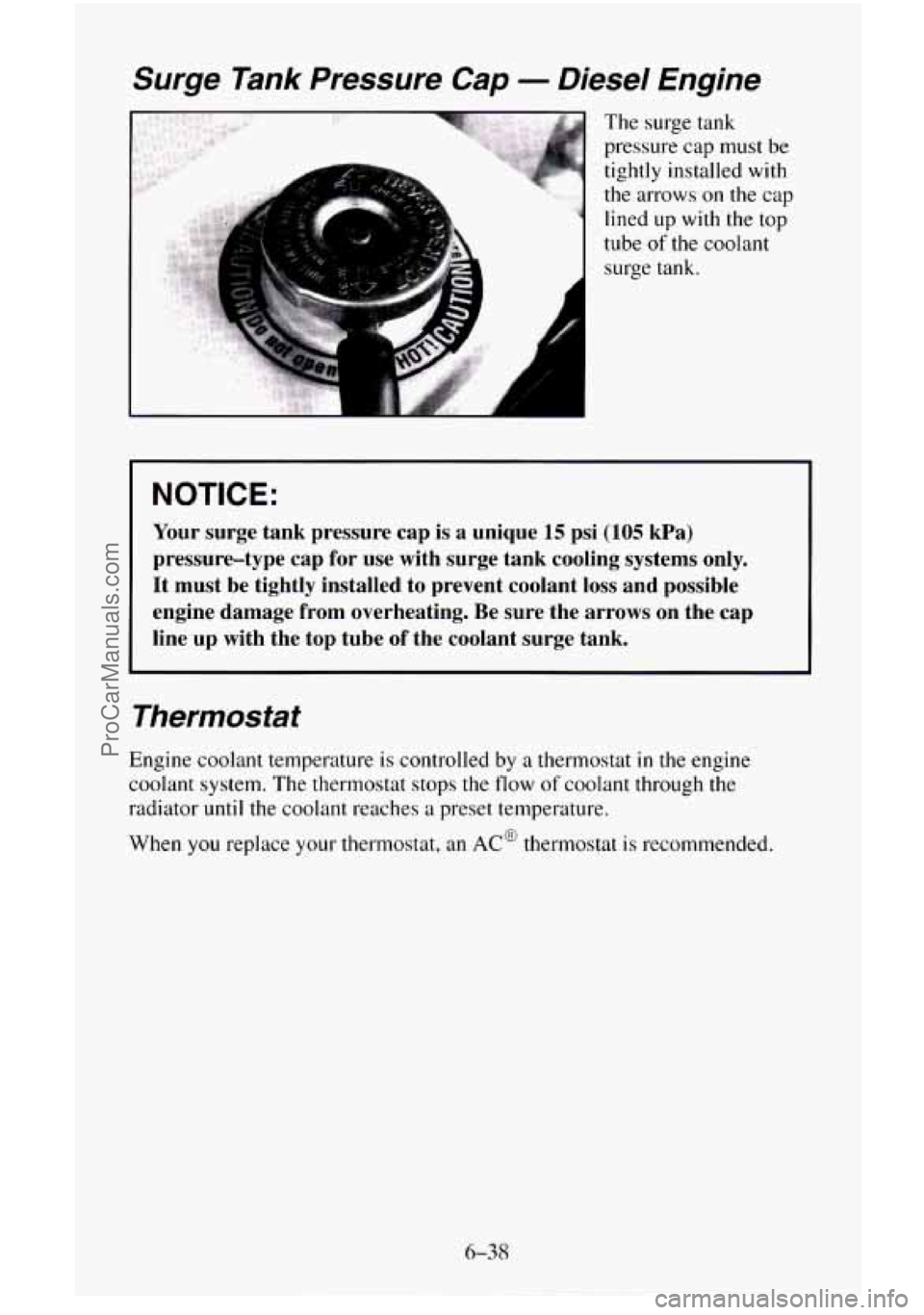
Surge Tank Pressure Cap - Diesel Engine
The surge tank
pressure cap must
be
tightly installed with
the arrows on the cap
lined up with the top
tube
of the coolant
surge tank.
NOTICE:
Your surge tank pressure cap is a unique 15 psi (105 kPa)
pressure-type cap for use with surge tank cooling systems only.
It must be tightly installed to prevent coolant
loss and possible
engine damage from overheating. Be sure the arrows on the cap
line up with the top tube of the coolant surge tank.
Thermostat
Engine coolant temperature is controlled by a thermostat in the engine
coolant system. The thermostat stops the flow
of coolant through the
radiator
until the coolant reaches a preset temperature.
When you replace your thermostat, an
AC@ thermostat is recommended.
6-38
ProCarManuals.com